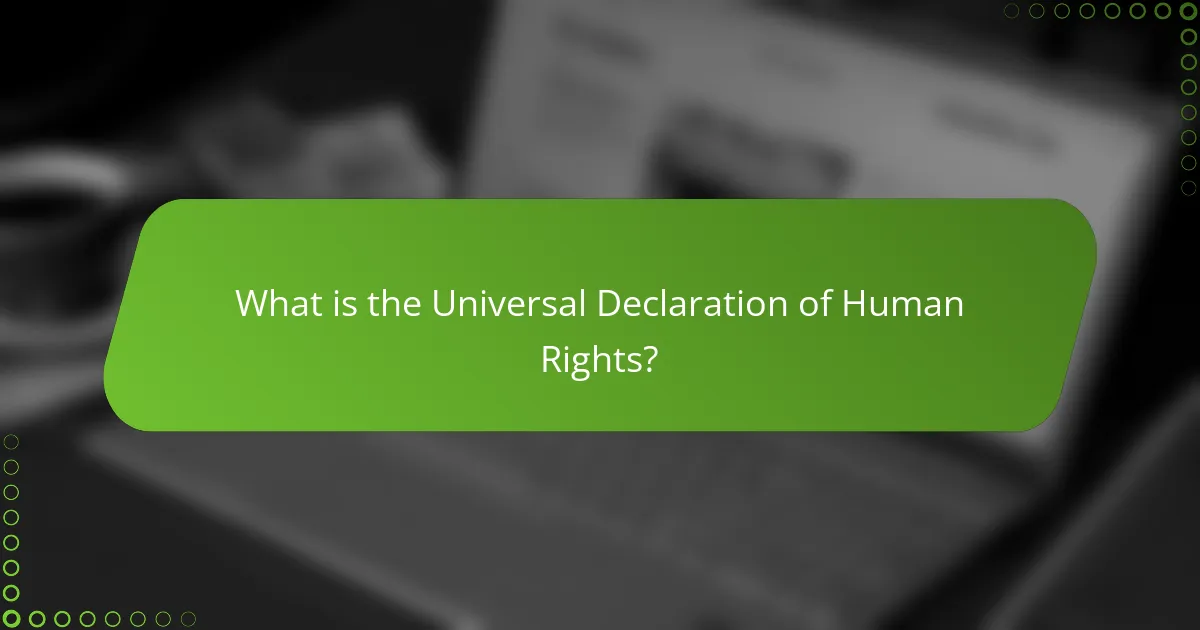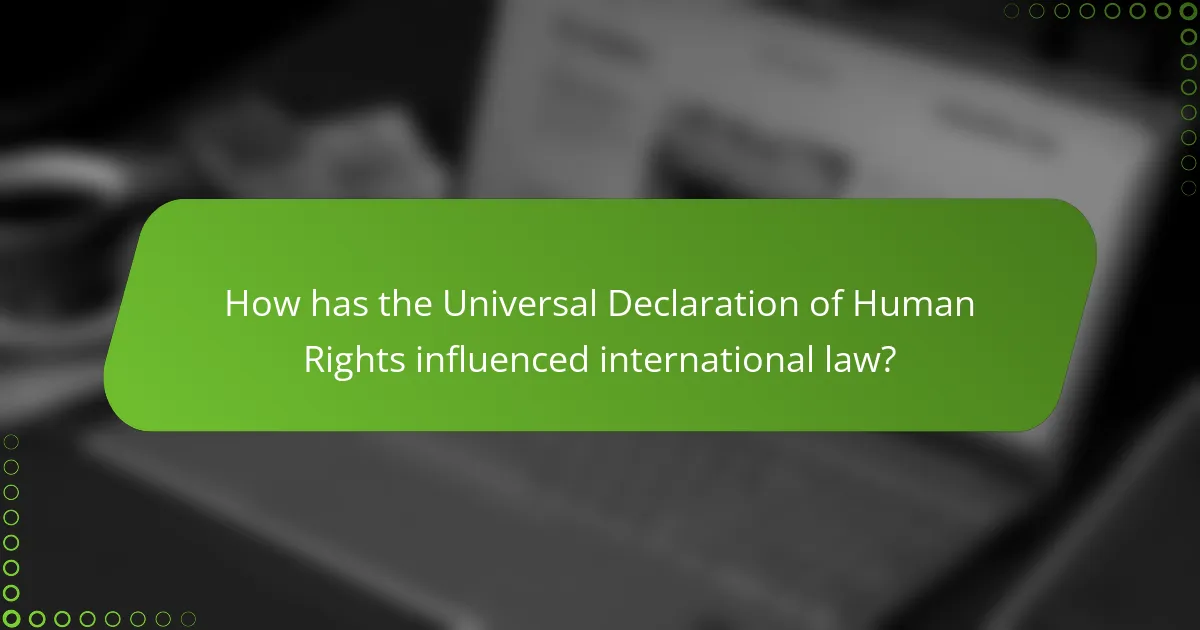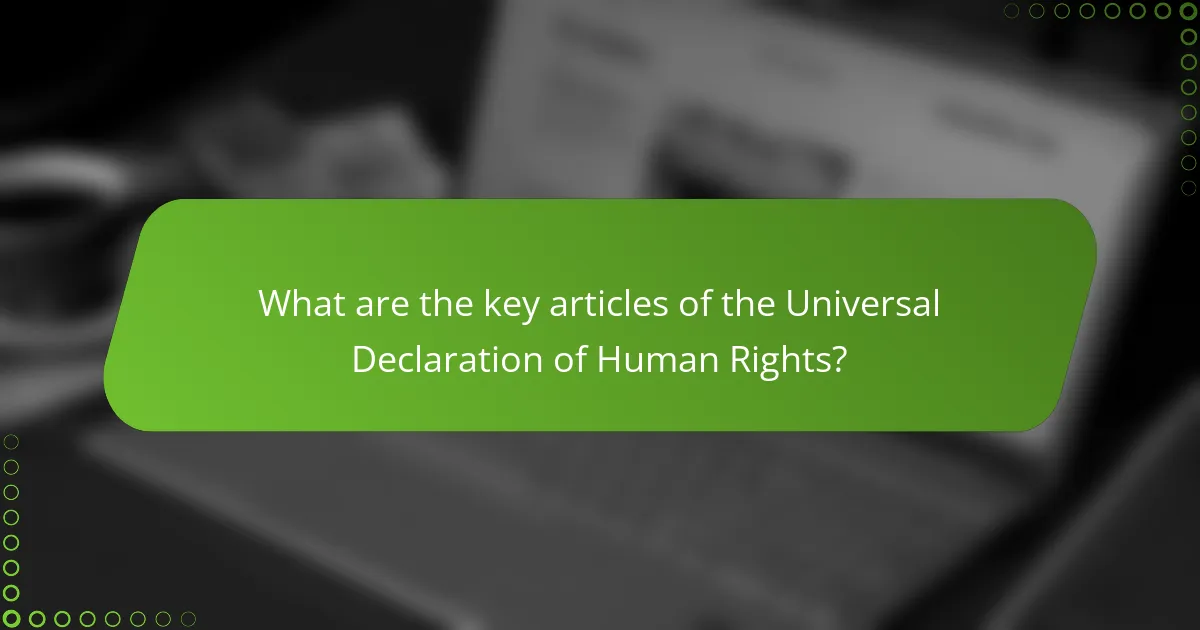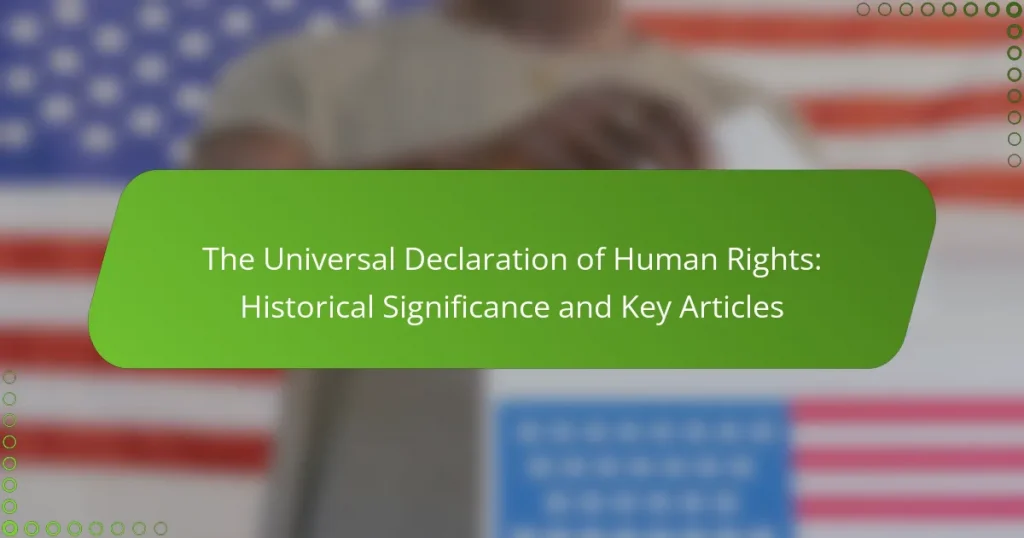The Universal Declaration of Human Rights (UDHR) is a foundational document in the history of human rights, adopted by the United Nations General Assembly on December 10, 1948. It consists of 30 articles that outline essential rights and freedoms, emphasizing the dignity and equality of all individuals. The UDHR has significantly influenced international law by establishing universal standards for human rights protection and inspiring numerous treaties and national constitutions. Key articles address fundamental rights such as the right to life, freedom from torture, equality before the law, and the right to education, forming the basis of international human rights law and promoting a global commitment to uphold these rights.

What is the Universal Declaration of Human Rights?
The Universal Declaration of Human Rights (UDHR) is a milestone document in the history of human rights. Adopted by the United Nations General Assembly on December 10, 1948, it outlines fundamental human rights to be universally protected. The UDHR consists of 30 articles detailing individual rights and freedoms. It emphasizes the inherent dignity and equal rights of all human beings. The declaration serves as a common standard for all nations. It has inspired numerous international treaties and national constitutions. The UDHR represents a global commitment to uphold human rights and promote peace.
Why was the Universal Declaration of Human Rights created?
The Universal Declaration of Human Rights was created to establish a common standard of human rights for all people. It aimed to address the atrocities committed during World War II. The declaration was adopted by the United Nations General Assembly on December 10, 1948. It was a response to the need for a universal framework to protect individual rights. The document outlines fundamental freedoms and rights that should be guaranteed to every person. It emphasizes dignity, equality, and respect for all individuals. The creation of the declaration was influenced by various human rights movements and philosophies. Its adoption marked a significant milestone in international human rights law.
What historical events led to the formation of the Universal Declaration of Human Rights?
The formation of the Universal Declaration of Human Rights was influenced by several historical events. The atrocities of World War II highlighted the need for universal human rights. The Holocaust and widespread human rights abuses prompted global outrage. The establishment of the United Nations in 1945 aimed to prevent future conflicts. In 1948, the UN General Assembly adopted the Declaration. The Declaration was influenced by earlier documents like the Magna Carta and the U.S. Bill of Rights. The global context of decolonization also contributed to its creation. These events collectively underscored the importance of protecting human rights worldwide.
Who were the key figures involved in drafting the Universal Declaration of Human Rights?
The key figures involved in drafting the Universal Declaration of Human Rights include Eleanor Roosevelt, René Cassin, Peng Chun Chang, Charles Malik, and Charles W. H. H. M. de la Mare. Eleanor Roosevelt served as the chair of the drafting committee and was instrumental in advocating for the document’s adoption. René Cassin is credited with composing the first draft of the declaration. Peng Chun Chang contributed a unique perspective, representing Asian viewpoints. Charles Malik played a significant role in promoting the universality of human rights. Charles W. H. H. M. de la Mare was involved in the final editing process. Their collective efforts resulted in the adoption of the declaration by the United Nations General Assembly on December 10, 1948.
What are the core principles of the Universal Declaration of Human Rights?
The core principles of the Universal Declaration of Human Rights include dignity, equality, and non-discrimination. These principles affirm that all individuals are entitled to fundamental rights and freedoms without distinction. The declaration emphasizes the inherent dignity of every person, which is essential for freedom, justice, and peace. Equality before the law is a fundamental tenet, ensuring that everyone has the right to legal protection against discrimination. Non-discrimination is crucial, advocating for equal rights regardless of race, gender, or religion. The principles are grounded in the belief that human rights are universal and should be upheld for all individuals globally.
How do these principles impact global human rights standards?
The principles of the Universal Declaration of Human Rights (UDHR) significantly shape global human rights standards. These principles establish foundational norms for dignity, freedom, and justice. They influence national laws and international treaties, promoting the protection of individual rights. Many countries incorporate UDHR principles into their constitutions and legal frameworks. This has led to increased accountability for human rights violations. The UDHR has inspired various human rights movements worldwide. It serves as a benchmark for assessing state compliance with human rights obligations. Global organizations, like the United Nations, reference these principles to advocate for human rights improvements.
What are the philosophical foundations of the Universal Declaration of Human Rights?
The philosophical foundations of the Universal Declaration of Human Rights are rooted in several key ideologies. These include natural law, which posits that certain rights are inherent to all individuals. Enlightenment thinkers such as John Locke emphasized individual rights and the social contract. The Declaration reflects these ideas by asserting that all humans possess inalienable rights.
Additionally, the principles of dignity and equality are central to its philosophy. The Declaration was influenced by various cultural and religious traditions, advocating for universal respect. Historical contexts, including the aftermath of World War II, also shaped its development. The document aims to prevent atrocities and promote peace by establishing common standards for human rights.

How has the Universal Declaration of Human Rights influenced international law?
The Universal Declaration of Human Rights (UDHR) has significantly influenced international law by establishing fundamental human rights standards. Adopted by the United Nations General Assembly in 1948, it set a universal benchmark for human rights protection. The UDHR has inspired numerous international treaties and conventions, including the International Covenant on Civil and Political Rights and the International Covenant on Economic, Social and Cultural Rights. These treaties incorporate the principles outlined in the UDHR into binding legal frameworks for states. Furthermore, the UDHR has shaped human rights jurisprudence in various international and regional courts. It provides a foundation for legal arguments and decisions regarding human rights violations. The UDHR’s influence extends to national legislation as countries adopt its principles into domestic law. Overall, the UDHR has played a crucial role in promoting and protecting human rights globally.
What role does the Universal Declaration of Human Rights play in the United Nations system?
The Universal Declaration of Human Rights (UDHR) serves as a foundational document for the United Nations system. It establishes a common standard of human rights for all nations. Adopted in 1948, the UDHR outlines fundamental rights and freedoms that every individual is entitled to. It guides UN member states in creating laws and policies that protect human rights. The UDHR influences international treaties and conventions on human rights. It also provides a framework for the UN’s human rights mechanisms, including the Human Rights Council. The declaration has inspired numerous national constitutions and legal systems worldwide. Its principles are referenced in various UN resolutions and reports, reinforcing its role in promoting global human rights.
How has the Universal Declaration of Human Rights shaped treaties and conventions?
The Universal Declaration of Human Rights (UDHR) has profoundly influenced international treaties and conventions. Adopted by the United Nations General Assembly in 1948, the UDHR set a global standard for human rights. It established foundational principles that serve as the basis for numerous subsequent treaties. For example, the International Covenant on Civil and Political Rights and the International Covenant on Economic, Social and Cultural Rights both draw from the UDHR’s core values. The UDHR has also inspired regional human rights instruments, such as the European Convention on Human Rights. Its impact extends to various UN conventions addressing specific issues, including the Convention on the Elimination of All Forms of Discrimination Against Women. The UDHR’s principles are now integral to international law, shaping how states formulate human rights obligations.
What are the mechanisms for enforcing the Universal Declaration of Human Rights?
The mechanisms for enforcing the Universal Declaration of Human Rights include international treaties, monitoring bodies, and national legislation. The UN Human Rights Council oversees the implementation of human rights standards. Special Rapporteurs report on specific human rights issues and violations. The Universal Periodic Review assesses the human rights records of all UN member states. Regional human rights systems, such as the European Court of Human Rights, provide additional enforcement mechanisms. Countries can also incorporate the principles of the Declaration into their national laws. Enforcement relies on state cooperation and the political will to uphold human rights.
How does the Universal Declaration of Human Rights affect national laws?
The Universal Declaration of Human Rights (UDHR) influences national laws by establishing a framework for human rights standards. Countries often incorporate UDHR principles into their legal systems. This incorporation can lead to the enactment of laws that protect individual rights. For example, many nations have laws against discrimination based on race, gender, or religion, reflecting UDHR articles. Furthermore, the UDHR serves as a reference for judicial decisions in human rights cases. Its principles encourage governments to align their laws with international human rights norms. Many constitutions worldwide explicitly reference the UDHR, reinforcing its impact on national legislation.
What examples exist of countries adopting the Universal Declaration of Human Rights into their legal systems?
Countries such as Canada, Germany, and South Africa have adopted the Universal Declaration of Human Rights (UDHR) into their legal systems. Canada incorporates the UDHR through the Canadian Charter of Rights and Freedoms. This charter guarantees fundamental rights and freedoms aligned with the UDHR principles. Germany’s Basic Law integrates UDHR principles, ensuring human dignity and fundamental rights are protected. South Africa’s Constitution explicitly references the UDHR, promoting equality and human rights post-apartheid. These examples illustrate how the UDHR has influenced national legal frameworks, reinforcing global human rights standards.
How do cultural differences influence the interpretation of the Universal Declaration of Human Rights?
Cultural differences significantly influence the interpretation of the Universal Declaration of Human Rights (UDHR). Different cultures prioritize various values and norms, affecting how human rights are understood. For instance, individualistic cultures may emphasize personal freedoms, while collectivist cultures focus on community rights. This divergence can lead to varied applications of rights, such as freedom of speech versus respect for communal harmony.
In regions with strong religious influences, interpretations of rights may align closely with religious doctrines. For example, some cultures may view gender equality through the lens of traditional roles, impacting women’s rights. Historical contexts also shape interpretations, as societies with colonial histories may approach human rights with skepticism.
Research, such as “Cultural Relativism and Human Rights” by Jack Donnelly, illustrates that cultural context alters the perception of rights. The UDHR aims for universality, yet its implementation can reflect local customs and beliefs. This complex interplay highlights the necessity of considering cultural perspectives in human rights discourse.

What are the key articles of the Universal Declaration of Human Rights?
The key articles of the Universal Declaration of Human Rights include 30 articles that outline fundamental human rights. Article 1 states that all humans are born free and equal in dignity and rights. Article 2 ensures the right to non-discrimination. Article 3 guarantees the right to life, liberty, and security. Article 4 prohibits slavery and servitude. Article 5 protects against torture and cruel treatment. Article 6 affirms the right to recognition as a person before the law. Article 7 ensures equality before the law and protection against discrimination. Article 8 provides the right to an effective remedy for violations of rights. Article 9 protects against arbitrary arrest and detention. Article 10 guarantees the right to a fair trial. Article 11 ensures the presumption of innocence until proven guilty. Article 12 protects against arbitrary interference with privacy. Article 13 guarantees the freedom of movement. Article 14 provides the right to seek asylum. Article 15 affirms the right to a nationality. Article 16 guarantees the right to marry and found a family. Article 17 protects the right to own property. Article 18 ensures freedom of thought, conscience, and religion. Article 19 guarantees freedom of opinion and expression. Article 20 protects the right to peaceful assembly and association. Article 21 guarantees the right to participate in government. Article 22 affirms the right to social security. Article 23 ensures the right to work and fair conditions. Article 24 guarantees the right to rest and leisure. Article 25 affirms the right to an adequate standard of living. Article 26 ensures the right to education. Article 27 guarantees the right to participate in cultural life. Article 28 affirms the right to a social and international order. Article 29 outlines duties to the community. Article 30 states that no one can take away the rights set forth in the declaration. These articles collectively form the foundation of international human rights law.
What rights are guaranteed by the Universal Declaration of Human Rights?
The Universal Declaration of Human Rights guarantees fundamental rights and freedoms to all individuals. These rights include the right to life, liberty, and security of person. It assures freedom from torture and inhumane treatment. Individuals have the right to recognition as a person before the law. The declaration guarantees equality before the law and protection against discrimination. It includes rights to privacy, freedom of thought, conscience, and religion. The right to freedom of opinion and expression is also protected. Additionally, it guarantees the right to peaceful assembly and association. These rights are enshrined in the declaration adopted by the United Nations General Assembly in 1948.
Which articles address civil and political rights?
Articles 3 to 21 of the Universal Declaration of Human Rights address civil and political rights. Article 3 states that everyone has the right to life, liberty, and security. Article 5 prohibits torture and cruel treatment. Article 6 affirms the right to recognition as a person before the law. Article 7 ensures equality before the law and protection against discrimination. Article 9 protects against arbitrary arrest and detention. Article 10 guarantees the right to a fair trial. Article 11 addresses the presumption of innocence until proven guilty. Article 18 protects the right to freedom of thought, conscience, and religion. Article 19 ensures the right to freedom of opinion and expression. Article 20 protects the right to peaceful assembly and association. Article 21 outlines the right to participate in government and public affairs. These articles collectively affirm the fundamental civil and political rights that are essential for individual freedom and democracy.
What articles focus on economic, social, and cultural rights?
Articles 22 to 27 of the Universal Declaration of Human Rights focus on economic, social, and cultural rights. Article 22 establishes the right to social security and the realization of economic, social, and cultural rights. Article 23 emphasizes the right to work, free choice of employment, and favorable working conditions. Article 24 recognizes the right to rest and leisure, including reasonable limitation of working hours. Article 25 asserts the right to an adequate standard of living, including food, clothing, housing, and medical care. Article 26 highlights the right to education, promoting free and compulsory primary education. Article 27 affirms the right to participate in cultural life and enjoy the benefits of scientific progress. These articles collectively underscore the importance of ensuring economic, social, and cultural rights for all individuals.
How are the articles of the Universal Declaration of Human Rights applied in practice?
The articles of the Universal Declaration of Human Rights (UDHR) are applied in practice through various mechanisms at international, national, and local levels. Governments implement these articles into domestic law, ensuring protection of rights such as freedom of speech and the right to education. International organizations, like the United Nations, monitor compliance and promote adherence to these rights globally. NGOs advocate for human rights, providing support to victims and raising awareness about violations. Courts and legal systems interpret and enforce these rights, offering remedies for breaches. Countries may also be held accountable through international treaties and conventions that align with the UDHR. For instance, the International Covenant on Civil and Political Rights, which builds on the UDHR, mandates state parties to respect and ensure rights outlined in the declaration.
What are the challenges in implementing the articles of the Universal Declaration of Human Rights?
Implementing the articles of the Universal Declaration of Human Rights faces several challenges. One significant challenge is the lack of political will among governments. Many states prioritize national interests over human rights. This can lead to selective enforcement of rights. Another challenge is cultural differences. Various cultures interpret human rights differently, which can cause conflicts. Additionally, economic constraints hinder implementation. Developing countries may lack resources to uphold these rights effectively. Furthermore, inadequate legal frameworks can prevent proper enforcement. In some regions, civil society is suppressed, limiting advocacy efforts. Lastly, global inequalities exacerbate these challenges. Wealth disparities affect the ability to uphold human rights universally.
How do various organizations promote the articles of the Universal Declaration of Human Rights?
Various organizations promote the articles of the Universal Declaration of Human Rights through education, advocacy, and outreach programs. They conduct workshops and seminars to inform individuals about their rights. Many organizations create educational materials, including brochures and online resources. Campaigns are launched to raise awareness on social media platforms. Partnerships with schools and universities help integrate human rights education into curricula. Additionally, organizations engage in lobbying efforts to influence policy changes at local and national levels. Reports and publications are often released to highlight human rights violations. These efforts aim to foster a culture of respect for human rights globally.
What can individuals do to support the Universal Declaration of Human Rights?
Individuals can support the Universal Declaration of Human Rights by advocating for human rights in their communities. They can raise awareness about human rights issues through education and public discourse. Participation in peaceful protests and campaigns can also amplify their voices. Supporting organizations that promote human rights is another effective action. Volunteering time or resources to these organizations can make a significant impact. Additionally, individuals can engage with policymakers to influence legislation that protects human rights. Signing petitions and supporting local initiatives can further contribute to the cause. These actions collectively strengthen the global commitment to uphold human rights as outlined in the Declaration.
The Universal Declaration of Human Rights (UDHR) is a landmark document adopted by the United Nations General Assembly on December 10, 1948, which outlines fundamental human rights that are to be universally protected. The article covers the historical context leading to its creation, key figures involved in its drafting, and the core principles that emphasize dignity, equality, and non-discrimination. It also discusses how the UDHR has influenced international law and national legislation, its application in practice, and the challenges faced in its implementation. Furthermore, the article highlights the rights guaranteed by the UDHR, including civil, political, economic, social, and cultural rights, and examines the role of various organizations and individuals in promoting these rights.




